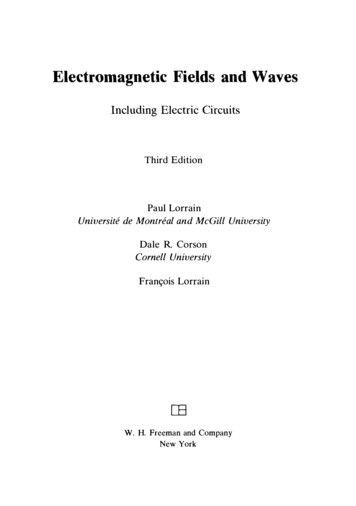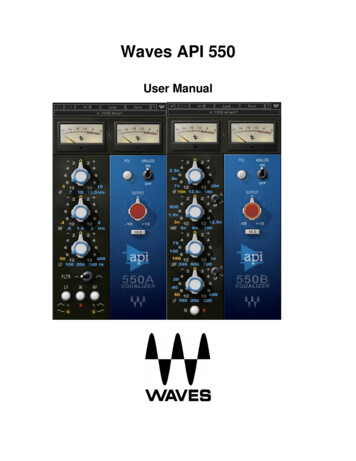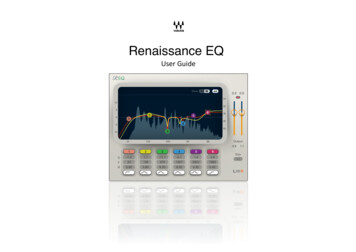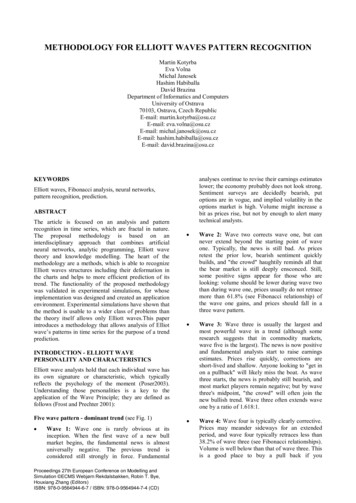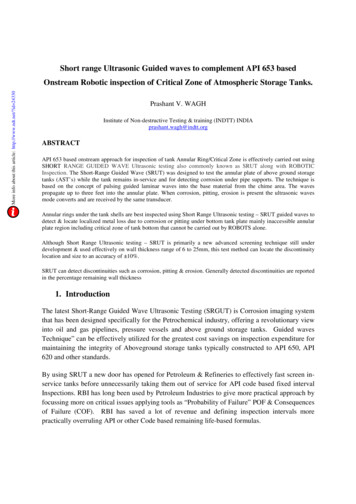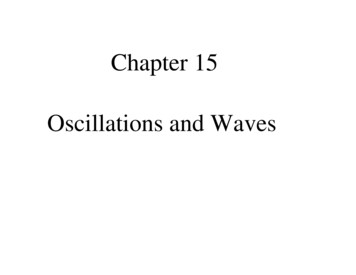
Transcription
Chapter 15Oscillations and Waves
Oscillations and Waves Simple Harmonic Motion Energy in SHM Some Oscillating Systems Damped Oscillations Driven Oscillations ResonanceMFMcGraw-PHY 2425Chap 15Ha-Oscillations-Revised 10/13/20122
Simple Harmonic MotionSimple harmonic motion (SHM)occurs when the restoring force(the force directed toward a stableequilibrium point) is proportionalto the displacement fromequilibrium.MFMcGraw-PHY 2425Chap 15Ha-Oscillations-Revised 10/13/20123
Characteristics of SHM Repetitive motion through a central equilibrium point. Symmetry of maximum displacement. Period of each cycle is constant. Force causing the motion is directed toward theequilibrium point (minus sign). F directly proportional to the displacement fromequilibrium.Acceleration - ω2 x DisplacementMFMcGraw-PHY 2425Chap 15Ha-Oscillations-Revised 10/13/20124
A Simple Harmonic Oscillator (SHO)Frictionless surfaceThe restoring force is F kx.MFMcGraw-PHY 2425Chap 15Ha-Oscillations-Revised 10/13/20125
Two Springs with Different AmplitudesFrictionless surfaceMFMcGraw-PHY 2425Chap 15Ha-Oscillations-Revised 10/13/20126
SHO Period is Independent of the AmplitudeMFMcGraw-PHY 2425Chap 15Ha-Oscillations-Revised 10/13/20127
The Period and the Angular FrequencyThe period of oscillation isT where ω is the angular frequency ofthe oscillations, k is the springconstant and m is the mass of theblock.MFMcGraw-PHY 2425Chap 15Ha-Oscillations-Revised 10/13/20122πω.ω km8
Simple Harmonic MotionAt the equilibrium point x 0 so, a 0 also.When the stretch is a maximum, a will be a maximum too.The velocity at the end points will be zero, andit is a maximum at the equilibrium point.MFMcGraw-PHY 2425Chap 15Ha-Oscillations-Revised 10/13/20129
Representing Simple Harmonic MotionMFMcGraw-PHY 2425Chap 15Ha-Oscillations-Revised 10/13/201210
Representing Simple Harmonic MotionMFMcGraw-PHY 2425Chap 15Ha-Oscillations-Revised 10/13/201211
Representing Simple Harmonic MotionPosition - xmax AVelocity - vmax ωAAcceleration - amax ω2AMFMcGraw-PHY 2425Chap 15Ha-Oscillations-Revised 10/13/201212
A simple harmonic oscillator can be describedmathematically by:x ( t ) Acosωtdxv (t ) -Aωsinωtdtdva (t ) -Aω 2 cosωtdtOr by:x ( t ) Asinωtdxv (t ) Aωcosωtdtdva (t ) -Aω 2 sinωtdtMFMcGraw-PHY 2425where A is the amplitude ofthe motion, the maximumdisplacement fromequilibrium, Aω vmax, andAω2 amax.Chap 15Ha-Oscillations-Revised 10/13/201213
Linear Motion - Circular FunctionsMFMcGraw-PHY 2425Chap 15Ha-Oscillations-Revised 10/13/201214
Projection of Circular MotionMFMcGraw-PHY 2425Chap 15Ha-Oscillations-Revised 10/13/201215
Circular Motion is the superposition of two linear SHO that are900 out of phase with each othery A sin(ωt )x A cos(ωt )MFMcGraw-PHY 2425Chap 15Ha-Oscillations-Revised 10/13/201216
Shifting Trig Functions sin x A ωt -φ cos x AThe minus sign means that thephase is shifted to the right.{ }sin t 2πϕ cos TA plus sign indicated the phaseis shifted to the leftx Asin ωt - π2 x A ( sinωt cos π2 - sin π2 cosωt )x A ( sinωt (0) - (1)cosωt )x -AcosωtMFMcGraw-PHY 2425Chap 15Ha-Oscillations-Revised 10/13/201217
Shifting Trig Functions π sin ωt - 02 Shifted Trig Functions1.50πωt - 02πωt 2π 11Tt ; ω 2π2ωπ TTt 2 2π 4MFMcGraw-PHY 0.001.002.00-0.50-1.00-1.50TimeChap 15Ha-Oscillations-Revised 10/13/2012183.00
EnergyMFMcGraw-PHY 2425Chap 15Ha-Oscillations-Revised 10/13/201219
Equation of Motion & EnergyAssuming the table is frictionless: FClassic form for SHMAlso,x - kx ma xka x ( t ) - x ( t ) - ω2 x ( t )m1 21 2E K ( t ) U ( t ) mv ( t ) kx ( t )22MFMcGraw-PHY 2425Chap 15Ha-Oscillations-Revised 10/13/201220
Spring Potential EnergyMFMcGraw-PHY 2425Chap 15Ha-Oscillations-Revised 10/13/201221
Spring Total EnergyMFMcGraw-PHY 2425Chap 15Ha-Oscillations-Revised 10/13/201222
Approximating Simple Harmonic MotionMFMcGraw-PHY 2425Chap 15Ha-Oscillations-Revised 10/13/201223
Approximating Simple Harmonic MotionMFMcGraw-PHY 2425Chap 15Ha-Oscillations-Revised 10/13/201224
Potential and Kinetic EnergyMFMcGraw-PHY 2425Chap 15Ha-Oscillations-Revised 10/13/201225
The period of oscillation of an object in an ideal mass-springsystem is 0.50 sec and the amplitude is 5.0 cm.What is the speed at the equilibrium point?At equilibrium x 0:1 2 1 2 1 2E K U mv kx mv222Since E constant, at equilibrium (x 0) theKE must be a maximum. Here v vmax Aω.MFMcGraw-PHY 2425Chap 15Ha-Oscillations-Revised 10/13/201226
Example continued:The amplitude A is given, but ω is not.2π2π 12.6 rads/secω T0.50 sand v Aω (5.0 cm )(12.6 rads/sec ) 62.8 cm/secMFMcGraw-PHY 2425Chap 15Ha-Oscillations-Revised 10/13/201227
The diaphragm of a speaker has a mass of 50.0 g and responds to asignal of 2.0 kHz by moving back and forth with an amplitude of1.8 10 4 m at that frequency.(a) What is the maximum force acting on thediaphragm?()22()F F ma mAω mA2πf 4πmAf maxmax22The value is Fmax 1400 N.MFMcGraw-PHY 2425Chap 15Ha-Oscillations-Revised 10/13/201228
Example continued:(b) What is the mechanical energy of the diaphragm?Since mechanical energy is conserved, E Kmax Umax.U maxK max1 2 kA21 2 mvmax2The value of k is unknown so use Kmax.K max 1 21122mvmax m( Aω ) mA2 (2πf )222The value is Kmax 0.13 J.MFMcGraw-PHY 2425Chap 15Ha-Oscillations-Revised 10/13/201229
Example: The displacement of an object in SHM is given by:y (t ) (8.00 cm )sin [(1.57 rads/sec ) t ]What is the frequency of the oscillations?Comparing to y(t) A sinωt gives A 8.00 cmand ω 1.57 rads/sec. The frequency is:ω 1.57 rads/secf 0.250 Hz2π2πMFMcGraw-PHY 2425Chap 15Ha-Oscillations-Revised 10/13/201230
Example continued:Other quantities can also be determined:The period of the motion is2π2πT 4.00 secω 1.57 rads/secxmax A 8.00 cmvmax Aω (8.00 cm )(1.57 rads/sec ) 12.6 cm/secamax Aω 2 (8.00 cm )(1.57 rads/sec ) 19.7 cm/sec22MFMcGraw-PHY 2425Chap 15Ha-Oscillations-Revised 10/13/201231
What About Gravity?When a mass-spring system is oriented vertically,it will exhibit SHM with the same period andfrequency as a horizontally placed system.The effect of gravity is canceled out.MFMcGraw-PHY 2425Chap 15Ha-Oscillations-Revised 10/13/201232
Why We Ignore Gravity with Vertical SpringsMFMcGraw-PHY 2425Chap 15Ha-Oscillations-Revised 10/13/201233
The Simple PendulumA simple pendulum is constructed by attaching amass to a thin rod or a light string. We will alsoassume that the amplitude of the oscillations issmall.MFMcGraw-PHY 2425Chap 15Ha-Oscillations-Revised 10/13/201234
The Simple PendulumThe pendulum is bestdescribed using polarcoordinates.The origin is at the pivotpoint. The coordinates are(r, φ). The r-coordinatepoints from the originalong the rod. The φcoordinate is perpendicularto the rod and is positive inthe counter clockwisedirection.MFMcGraw-PHY 2425Chap 15Ha-Oscillations-Revised 10/13/201235
Fφ mg sin φ maφndApply Newton’s 2Law to the pendulumbob.2v Fr T mg cos φ m rIf we assume that φ 1 rad, then sin φ φ and cos φ 1, the angularfrequency of oscillations is then: Fφ mg sin φ maφ mLα mg sin φ mLαα ( g / L) sin φα ( g / L)φThe period of oscillations isMFMcGraw-PHY 2425ω T gL2πωChap 15Ha-Oscillations-Revised 10/13/2012 2πLg36
Example: A clock has a pendulum that performs one full swingevery 1.0 sec. The object at the end of the string weighs 10.0 N.What is the length of the pendulum?LT 2πggT 2 (9.8 m/s 2 )(1.0 s )L 0.25 m224π4π2Solving for L:MFMcGraw-PHY 2425Chap 15Ha-Oscillations-Revised 10/13/201237
The gravitational potential energy of a pendulum isU mgy.Taking y 0 at the lowest point of the swing, show that y L(1-cosθ).θLcosθLLy L(1 cos θ )y 0MFMcGraw-PHY 2425Chap 15Ha-Oscillations-Revised 10/13/201238
The Physical PendulumA physical pendulum is any rigid object that is free tooscillate about some fixed axis. The period ofoscillation of a physical pendulum is not necessarily thesame as that of a simple pendulum.MFMcGraw-PHY 2425Chap 15Ha-Oscillations-Revised 10/13/201239
The Physical PendulumIT 2πMgDI is the moment of inertia aboutthe given axis. The Icm from thetable will need to be modifiedusing the parallel axis theorem.MFMcGraw-PHY 2425Chap 15Ha-Oscillations-Revised 10/13/201240
Compound PendulumIT 2πMgDI Irod IdiskM mrod MdiskD distance from the axis tothe center of mass of the rodand disk.MFMcGraw-PHY 2425Chap 15Ha-Oscillations-Revised 10/13/201241
Damped OscillationsWhen dissipative forces such as friction are notnegligible, the amplitude of oscillations will decreasewith time. The oscillations are damped.MFMcGraw-PHY 2425Chap 15Ha-Oscillations-Revised 10/13/201242
Damped Oscillations Equationsd 2xdxm 2 b mω0 x 0dtdt-t x(t) A0 exp cos( ω ' t δ) 2τ 'ω ω0 b 1- 2mω0 2ω0 kmτ m; bc 2mω0bFor b bc the system is overdamped. For b bc the system iscritically damped. The object doesn’t oscillate and returns to itsequilibrium posion very rapidly.MFMcGraw-PHY 2425Chap 15Ha-Oscillations-Revised 10/13/201243
Damped OscillationsMFMcGraw-PHY 2425Chap 15Ha-Oscillations-Revised 10/13/201244
Graphical representations of damped oscillations:MFMcGraw-PHY 2425Chap 15Ha-Oscillations-Revised 10/13/201245
Damped Oscillations Overdamped: The system returns to equilibrium withoutoscillating. Larger values of the damping the return toequilibrium slower. Critically damped : The system returns to equilibrium asquickly as possible without oscillating. This is oftendesired for the damping of systems such as doors. Underdamped : The system oscillates (with a slightlydifferent frequency than the undamped case) with theamplitude gradually decreasing to zero.Source: Damping @ WikipediaMFMcGraw-PHY 2425Chap 15Ha-Oscillations-Revised 10/13/201246
Damped OscillationsThe larger the damping the more difficult it is to assigna frequency to the oscillation.MFMcGraw-PHY 2425Chap 15Ha-Oscillations-Revised 10/13/201247
Damped Oscillations2EαAMFMcGraw-PHY 2425Chap 15Ha-Oscillations-Revised 10/13/201248
Forced OscillationsMFMcGraw-PHY 2425Chap 15Ha-Oscillations-Revised 10/13/201249
Forced Oscillations and ResonanceA force can be applied periodically to a damped oscillator(a forced oscillation).When the force is applied at the natural frequency of thesystem, the amplitude of the oscillations will be amaximum. This condition is called resonance.MFMcGraw-PHY 2425Chap 15Ha-Oscillations-Revised 10/13/201250
Forced Oscillations Equationsd 2xdxm 2 b mω0 x F0 cosωtdtdtmafrictionspringapplied forcex Acos( ωt - δ )A F0m 2 (ω02 - ω 2 )2 b 2 ω 2MFMcGraw-PHY 2425bωtanδ m(ω02 - ω 2 )Chap 15Ha-Oscillations-Revised 10/13/201251
Energy and Resonanced 2xdxm 2 b mω0 x F0 cosωtdtdtAt resonance v and Fo are in phasevx dx -ωAsin(ωt - δ)dtv x -ωAsin(ωt --tEnergy α A2 A02 exp τ -tE 21 mω 2 A2 E0 exp τ E0 21 mω 2 A02 ; τ m bMFMcGraw-PHY 2425π2) ω Acosωtω0 mQ ω0 τ bChap 15Ha-Oscillations-Revised 10/13/201252
Power Transferω0Q ωThe dissipation in the system, represented by “b” keeps theamplitude from going to infinity.MFMcGraw-PHY 2425Chap 15Ha-Oscillations-Revised 10/13/201253
Tacoma Narrows BridgeNov. 7, 1940MFMcGraw-PHY 2425Chap 15Ha-Oscillations-Revised 10/13/201254
Tacoma Narrows BridgeNov. 7, 1940MFMcGraw-PHY 2425Chap 15Ha-Oscillations-Revised 10/13/201255
Tacoma Narrows BridgeThe first Tacoma Narrows Bridge opened to traffic on July 1, 1940. Itcollapsed four months later on November 7, 1940, at 11:00 AM (Pacifictime) due to a physical phenomenon known as aeroelastic flutter causedby a 67 kilometres per hour (42 mph) wind.The bridge collapse had lasting effects on science and engineering. Inmany undergraduate physics texts the event is presented as an example ofelementary forced resonance with the wind providing an external periodicfrequency that matched the natural structural frequency (even though thereal cause of the bridge's failure was aeroelastic flutter[1]).Its failure also boosted research in the field of bridge aerodynamics/aeroelastics which have themselves influenced the designs of all theworld's great long-span bridges built since 1940. - Wikipediahttp://www.youtube.com/watch?v 3mclp9QmCGsMFMcGraw-PHY 2425Chap 15Ha-Oscillations-Revised 10/13/201256
Normal Mode VibrationsMFMcGraw-PHY 2425Chap 15Ha-Oscillations-Revised 10/13/201257
End of Chapter ProblemsMFMcGraw-PHY 2425Chap 15Ha-Oscillations-Revised 10/13/201258
Chap 14 - #92MFMcGraw-PHY 2425Chap 15Ha-Oscillations-Revised 10/13/201259
Extra SlidesMFMcGraw-PHY 2425Chap 15Ha-Oscillations-Revised 10/13/201260
The Full Wave Equation 2 y 1 2 y- 2 2 02 x v ty(t) Asin(kx -ωt)2π2πk ; ω 2πf λT x t y(t) Asin 2π - λ T Traveling with the wave the phase is constantx t- Constantλ TMFMcGraw-PHY 2425dx dt- 0λ Tdx λ λf vdt TWave velocityChap 15Ha-Oscillations-Revised 10/13/201261
2 ω π T where ω is the angular frequency of the oscillations, k is the spring constant and m is the mass of the block. m k ω The Period and the Angular Frequency. MFMcGraw-PHY 2425 Chap 15Ha-Oscillations-Revised 10
